Roti canai
Roti canai (pronunciation: /tʃanaɪ/), or roti chenai,[9] also known as roti cane (/tʃane/) and roti prata, is an Indian-influenced flatbread dish found in several countries in Southeast Asia, including Brunei, Indonesia, Malaysia and Singapore. It is usually served with dal or other types of curry, but can also be cooked in a range of sweet or savoury variations made with a variety of ingredients such as meat, egg, or cheese. Roti canai is a popular breakfast and snack dish in Malaysia, and one of the most famous examples of Malaysian Indian cuisine.[10] It is said that the dish was brought over from India by Indian Muslims, also known as "Mamaks" in Malaysia, and is served in Mamak stalls located in both rural and urban Malaysia.[11][12]
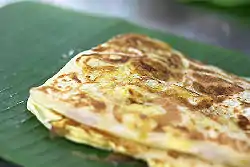 Roti canai | |
| Alternative names |
|
|---|---|
| Type | Flatbread |
| Course | Main course |
| Place of origin | Indonesia,[1][2] Malaysia,[3][4][5][6] and Singapore[7] |
| Region or state | Brunei, Indonesia,[8] Malaysia, Singapore and Thailand |
| Serving temperature | Hot |
| Main ingredients | Flour |
| Variations | Paratha |
| 302 kcal (1264 kJ) | |
It is considered as a variation of parotta and does exist in Kerala, India. The closest kin to roti canai is believed to be Malabar parotta.
Etymology
Roti means bread in Sanskrit, and most other Indian languages.[13] There are different suggestions for the origin of canai: it has been claimed that canai refers to Chennai (the bread can be written as roti chennai), the Indian city formerly known as Madras;[14][15] or from channa, a Northern Indian dish made with boiled chickpeas in a spicy gravy, with which this type of bread was traditionally served.[16] The Oxford English Dictionary, however, states that it came from the Malay word canai, meaning "to roll (dough) thinly".[9]
In Southern Malaysia and in Singapore the dish is known as roti prata, similar to the Indian paratha or parotta.[17] The Hindi word paratha means "flat".[18][19]
Description
Roti canai is made from dough which is usually composed of fat (usually ghee), flour and water; some recipes also include sweetened condensed milk. The dough is repeatedly kneaded, flattened, oiled, and folded before proofing, creating layers. The dough ball is then flattened, spread out until paper thin (usually by "tossing" it on a flat surface), and gathered into a long rope-like mass. This "rope" is then wound into a knot or spiral and flattened, so that it consists of thin flakes of dough when cooked.
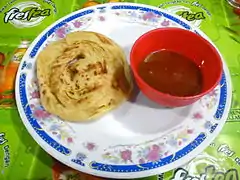
Up until the 1970s, it was common for cooks to form a spiral with the "rope" (much like the modern "roti bomb"), but this is no longer the case, probably because the amount of dough used per roti is about half of what it used to be. When making varieties with fillings, however, the fillings (eggs, chopped onions, etc.) are spread or sprinkled on the thin sheet of dough, which is then folded with the fillings inside.

Regional variations
Malaysia
Plain roti is often referred to as roti kosong ("empty bread" in Malay).[20]
Traditionally, roti canai is served with dal (lentil) curry. It may also be served with the following curries:
- Kari ayam, chicken curry
- Kari daging, beef curry
- Kari kambing, mutton curry
- Kari ikan, fish curry (mostly served with ikan pari)
- Kari campur, mixed curry
- Kari kacang kuda, a chickpea curry
Different varieties of roti canai served in Malaysia are listed below:
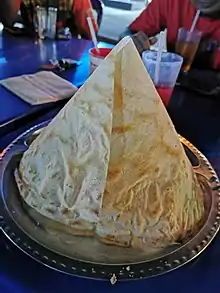
- Murtabak, a very thick roti filled with a mixture of egg, meat, onions and spices. In Malaysia and Singapore it is usually prepared on a griddle like roti canai, but in Indonesia, it is often deep fried in a wok and very oily. In Thailand, it is called "Mataba". In Malaysia, Singapore and Thailand murtabak is made using the same dough used to make roti canai, and on the same equipment in the same shops. Most murtabak in Malaysia tend to have less minced meat and more egg than Singaporean murtabak or Johorean Murtabak. Murtabak cheese is a variation with added mozzarella cheese.
- Roti telur, with an egg (telur).
- Roti jantan, roti telur with an extra egg.
- Roti bawang, with onions (bawang).
- Roti telur bawang, with eggs (telur) and onions (bawang).
- Roti boom (or bom) (bomb bread), a smaller but thicker roti, with the dough wound in a spiral. Served sweet, with sugar, and with margarine, or served with curry.
- Roti planta, stuffed with margarine (often Planta Margarine) and sugar.
- Roti sardin, stuffed with canned sardinewith/without egg and sometimes mixed with ketchup or sambal, similar to murtabak
- Roti pisang, stuffed with sliced bananas.
- Roti sayur. stuffed with shredded or sliced vegetables.
- Roti salad, raw shredded vegetables rolled up with a piece of roti.
- Roti tissue / roti tisu, a tissue paper-thin and flaky roti, usually with sprinkled sugar and condensed milk. Also called roomali roti, from roomal (Hindi, meaning handkerchief).
- Roti kaya, with kaya spread.
- Roti tampal or Roti plaster (in Singapore), similar to roti telur but the egg is cooked on the outside of the roti and the yolk still runny. Similar to egg in the basket and khachapuri.
- Roti maggi, stuffed with prepared instant noodles, usually Maggi Brand.
- Roti cheese, stuffed with cheese.
- Roti milo, with Milo powder
- Roti cobra, a roti served with curry chicken and piece of fried egg on top.
- Roti banjir ("flooded roti"), with much curry poured over the top.
- Roti tsunami ("tidal wave roti"), topped with curry sauce, sambal, and soft-boiled eggs.
- Roti Sarang Burung ("bird's nest roti"), stuffed with fried egg.
Indonesia
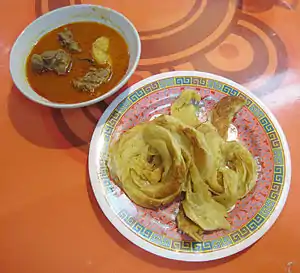
In Indonesia, roti canai is also called roti cane, roti konde or roti maryam,[8] and is usually served with kari kambing (mutton curry).[21] Roti cane came into Indonesia via the influx of Muslim Indian migration to Aceh Sultanate in Northern parts of Sumatra circa 17th century, and later to the rest of Dutch East Indies in early 19th century.[21] Roti canai is more prevalent in Sumatra, especially in Aceh, North and West Sumatra. Roti cane has been adopted by the Malay cuisine of Sumatra, Acehnese cuisine and Minangkabau cuisine. Consequently, there are Malay, Aceh, and Minangkabau restaurants that serve roti canai with mutton curry in Indonesia that are operated by ethnic groups other than Indians. This Indian-origin dish has been so well-integrated into Aceh cuisine that it is considered their own.[21]
In Ampel, an Arab quarter in Surabaya, it is known as roti maryam, while common Javanese called it roti konde after its similar shape to a hairbun (Javanese: konde). Despite having different names, their recipes are quite similar, and they are influenced by Indian paratha.[8]
Singapore
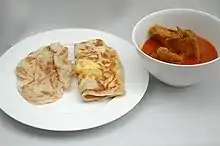
Roti prata is a fried flatbread that is cooked over a flat grilling pan. It is usually served with a vegetable- or meat-based curry and is also commonly cooked with cheese, onions, bananas, red beans, chocolate, mushrooms or eggs. Roti prata is prepared by flipping the dough into a large thin layer before folding the outside edges inwards. The dough is cooked on a flat round iron pan measuring about three feet in diameter. The cooking process lasts two to five minutes. Many of the roti canai variations found in Malaysia are also popular in Singapore.
Thailand
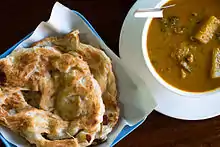
In Thailand, roti (with variations on spelling such as ro tee) is commonly sold from street carts, usually by Muslims, and is usually Halal. Roti thitchu (Thai for "tissue") is Thai roti canai that is fluffed up by clapping it between two hands inside a dry cloth after frying, served with a Thai-Muslim style beef curry.
Unlike in Malaysia, Singapore or Indonesia, variations in Thailand tend towards the sweet rather than the spicy or savoury. Popular variations include mango, banana, sugar, condensed milk, jam, peanut butter and Nutella roti, although egg roti (often with sweetened condensed milk spread over the top) is also available. Some stalls sell mataba (the equivalent of the Malaysian murtabak), though this is usually found in restaurants that sell Indian Muslim food such as Biryani rice rather than at roti stalls.
Gallery
 The mixture is kneaded, flattened, and then oiled, before being folded repeatedly.
The mixture is kneaded, flattened, and then oiled, before being folded repeatedly. Roti canai is cooked on a flat iron skillet with a lot of oil.
Roti canai is cooked on a flat iron skillet with a lot of oil.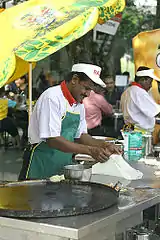 Another picture of Roti canai making.
Another picture of Roti canai making. A sweet Thai roti kluai khai: similar to roti canai, it is folded around a filling of sliced bananas and eggs..
A sweet Thai roti kluai khai: similar to roti canai, it is folded around a filling of sliced bananas and eggs..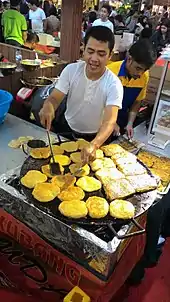 Martabak Kubang and roti cane making in Indonesia.
Martabak Kubang and roti cane making in Indonesia. Roti Canai with Curry Chicken dish in New Zealand.
Roti Canai with Curry Chicken dish in New Zealand. Roti prata being prepared.
Roti prata being prepared. "Coin prata" is a smaller, crispier version of Singaporean roti prata
"Coin prata" is a smaller, crispier version of Singaporean roti prata
References
- "Roti Canai". Tribunnewswiki.
- "Mencoba Roti Canai Asli Aceh di Tepi Jalan Pasar Minggu". Liputan6.
- "What is roti canai, and why can't people in Southeast Asia get enough of it?". SCMP.
- "The Indian Roti That Became Malaysia's National Bread". Taste.
- "Roti Canai (Mamak Copycat)". NyonyaCooking.
- "Roti Canai Kuala Lumpur takes a flatbread to new heights". WSJ.
- "Roti Prata". Visit Singapore.
- "Roti Maryam/Konde/Cane/Canai". Indonesia Eats.
- "roti canai, n." Oxford English Dictionary. Retrieved 20 January 2020.
- Krich, John (31 July 2009). "Roti Canai". The Wall Street Journal. ISSN 0099-9660. Retrieved 16 April 2018.
- "Malaysia's 5 mamak stall favorites | CNN". Retrieved 16 April 2018.
- "The 10 types of roti you'll find at the mamak". Time Out Kuala Lumpur. Retrieved 16 April 2018.
- "Roti canai, a popular snack | The Star Online". The Star. Malaysia. Archived from the original on 17 April 2018. Retrieved 16 April 2018.
- Olmedo, Eric (16 July 2015). dentity at Work: Ethnicity, Food & Power in Malaysian Hospitality Industry. Springer. p. 60. ISBN 9789812875617.
- "Roti Canai: A Favourite Of Many". azhariahkamin.com. 26 November 2015. Retrieved 16 April 2018.
- Wijnen, Ben van. "Roti Canai (Malay Recipe)". malaysiasite.nl. Retrieved 16 April 2018.
- Koh, Aun. "Roti Prata – Words Without Borders". Words Without Borders. Retrieved 16 April 2018.
- Koh, Aun. "Roti Prata – Words Without Borders". Words Without Borders. Retrieved 16 April 2018.
- "Roti Prata". Retrieved 16 April 2018.
- Krich, John (31 July 2009). "Roti Canai". The Wall Street Journal.
- Ni Luh Made Pertiwi F (2 April 2013). "Roti Cane dan Kari Kambing, Pasangan Sejati Nan Lezat" (in Indonesian). Kompas.com. Retrieved 23 July 2014.
External links
| Wikimedia Commons has media related to Roti canai. |
- Roti Prata Video Recipe
- Roti Prata, Singapore Infopedia, National Library Board, Singapore

